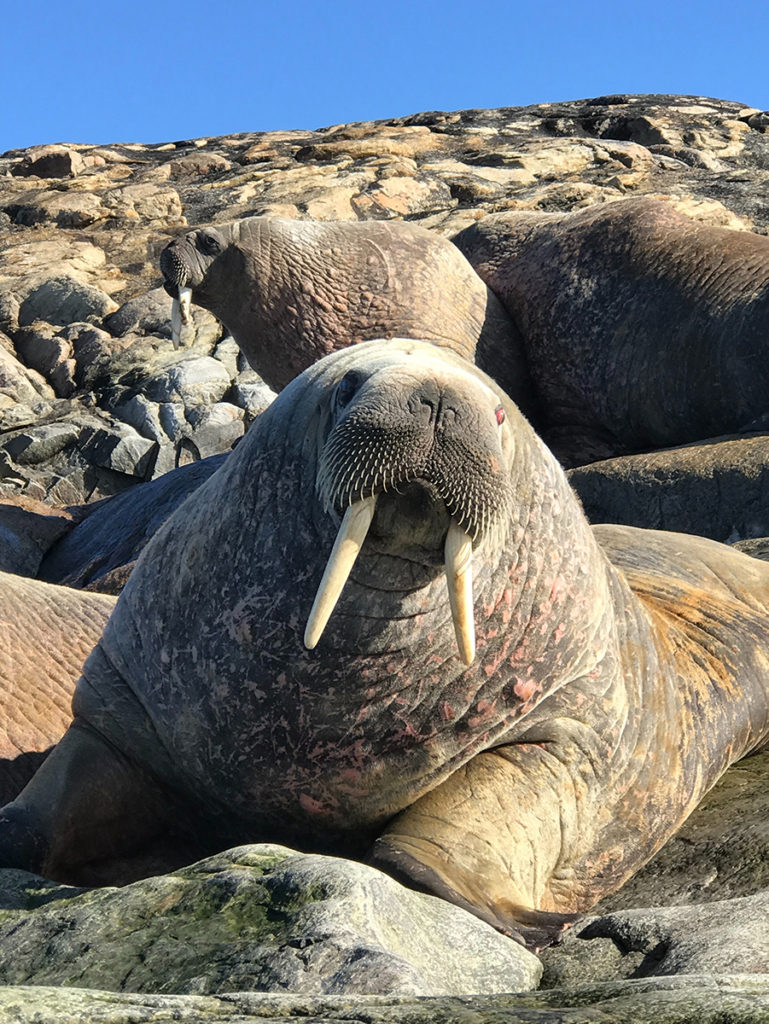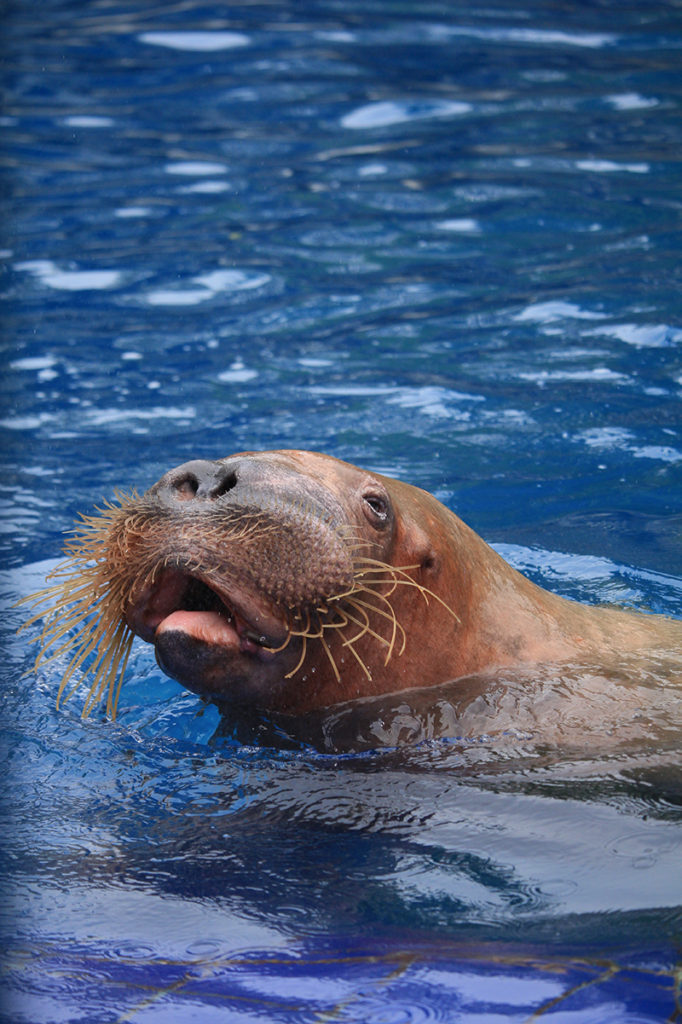The majestic Walrus is a gentle giant of the Arctic, but much of what is thought of them is wrong. What do walruses eat? How big do they get? Are they dangerous? The perception of this magnificent mammal is quite different to the reality; they are social, sensitive creatures preferring to stay in shallow waters of the Arctic ocean to feed of aquatic invertebrates. What are invertebrates? Let us elaborate below.
There are 2 subspecies of Walrus: Pacific and Atlantic. Pacific Walruses (Odobenus rosmarus divergens) are found in the Bering, East Siberian, Chukchi and Laptev seas, whereas the Atlantic Walrus (Odobenus rosmarus rosmarus) inhabits the Eastern Arctic of Canada, Greenland, Norway and Russia.
Migration
While the Atlantic Walrus are believed to remain in the same general areas year-round, Pacific Walrus are migratory. They spend the winter months in the Bering Sea and migrate to the Chukchi Sea for summer. Pacific Walrus calves are born during the migration and spend most of their time on ice floes while their mothers hunt for food.
There are approximately 25,000 Atlantic Walrus in the wild, compared to 200,000 Pacific Walrus. Due to the fact they spend a lot of time in the sea, these numbers are estimated based on surveys of their territorial ranges. Despite inhabiting different geographical territories, what both subspecies of walruses eat is very similar.
Also Read: Where Do Snakes Go in the Winter?
Appearance
Walruses are Pinnipeds – semiaquatic, fin-footed mammals – and are the largest Pinnipeds to inhabit the Arctic. Both subspecies look remarkably similar, with their greyish skin, coarse red hairs and thick, bristled whiskers. The biggest difference between Pacific and Atlantic Walrus is their size.
Pacific Walrus are larger, with males (also called bulls) weighing anywhere between 800 and 1800kg and females (cows) 400 – 1200kg. The smaller Atlantic Walrus is still a hefty beast, with males capable of weighing 1200-1500kg, although most are around 900kg. Females are much smaller, weighing no more than 700kg.

In terms of size, Atlantic males reach a length of almost 3m, with females slightly shorter at 2.5m. Pacific males can reach an enormous 3.7m, with females not far behind at roughly 3.1m long.
All Walrus have large tusks, which are actually canine teeth. Males have longer and thicker tusks which they use to display their dominance during the breeding season. Both males and females also use their tusks to haul out of the sea onto ice sheets and to create breathing holes in the ice.
Walrus calves are born with an ash grey skin fur. Within 2 weeks of birth, their fur turns a reddish-brown and they will shed this infant hair at arounds 2 months of age. From then, they will shed their coat annually. Adult males tend to have a pinkish hue to their skin, whereas females retain a greyish-brown colour.
Walruses use their highly sensitive whiskers to search for food. Without these, walruses would not be able to find anything to eat. They love shellfish and will scavenge the sea floor close to the shore, at an average depth of 20m although they are capable of diving up to 100m.
Walrus Lifespan
Walruses are long-lived animals, living as long as 40 years. They are relatively slow to reproduce, with a gestation of around 15 months. Walrus mothers nurse their calf for around 2 years. After mating, pregnancy will be delayed for 4 or 5 months. This allows the mother to recover from her previous pregnancy and birth, while also ensuring that her calf will be born when food is plentiful.
The most common causes of death for adult males are injuries sustained from fighting. It is also quite common for calves to be crushed by adults, especially during a stampede. Walruses are sensitive animals and will rush to the water if they are disturbed.
Walruses are also susceptible to viruses, parasites (both internal and external) and infections on their skin caused by microbes.
Did you know that walruses spend two thirds of their life in the water? That is mainly to forage for food. However, when they get out to rest, they can sleep for up to 19 hours.
Walrus Behaviour
Walruses are very social creatures. They will haul out (leave the water) onto ice sheets in groups of 20 to 50, with males and females forming separate herds. Herd dominance is established via tusk length, body size and the aggressiveness of each individual. Adolescent Walruses tend to remain on the edges of the herd to avoid any territorial squabbles.
Mothers are very protective of their calves and will shelter their calf under their chest, between their front flippers. While swimming, calves often ride on their mother’s back, swimming freely only when they want to nurse.
When it comes to courting, male Walruses are very vocal. Under the water, they are capable of producing loud bell-like sounds, as well as clicks, barks and whistles.
What Do Walruses Eat?
It would be natural to assume that Walrus eat fish, just like Seals and Sea Lions, however, Walrus actual feed on marine invertebrates and crustaceans including:
- Clams
- Molluscs
- Mussels
- Sea cucumbers
- Shrimp
- Crab
Adults are capable of eating 3000-6000 clams in one feeding session! Generally, walruses will eat twice per day during the winter months, but during summer, they spend most of the day foraging.
Occasionally, when food is scarce, they may feed of the carcasses of other seals and walruses. They may also hunt small fish.
Due to the murky water and low visibility, walruses use their flat snout to disturb the sediment and their whiskers, or vibrissae, to detect prey on the sea floor. They also use their front flippers to dig out prey from the sediment. Researchers have also observed Walruses taking mouthfuls of water and squirting them at the sea floor to move the sediment in their hunt for food.

Nursing mothers will be accompanied by their calves during their hunts and a calf will nurse in the water whenever they need to. From the age of 6 months, calves will start to try solid food but will continue to nurse from their mother until they are 2 years old.
Walrus Predators
Due to their large size and ability to protect themselves, Walruses do not have many natural predators. Polar bears and Orcas have been known to prey on Walrus calves and injured adults, but they would not normally hunt a healthy adult.
Humans are a much bigger threat to Walruses than any Artic predator. They were hunted commercially by traders for their valuable tusks, meat and hide. It was not until the early 1900s that commercial hunting was banned, however, Indigenous Arctic communities still hunt Walrus. They provide essential resources such as meat for food, hide for clothing and blubber for soap and oil burning lamps.
Also Read: How To Drive a Snowmobile?

